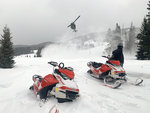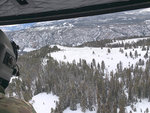Cloudy, 26° F
By the time the two men were reported lost in the Beartooth Mountains on Thursday night, Trevor Wayne Deal of Bridger and Maison Ostwald, of Laurel, Montana, had been out in the elements for 12 …
This item is available in full to subscribers.
The Powell Tribune has expanded its online content. To continue reading, you will need to either log in to your subscriber account, or purchase a subscription.
If you are a current print subscriber, you can set up a free web account by clicking here.
If you already have a web account, but need to reset it, you can do so by clicking here.
If you would like to purchase a subscription click here.
Please log in to continue |
|



By the time the two men were reported lost in the Beartooth Mountains on Thursday night, Trevor Wayne Deal of Bridger and Maison Ostwald, of Laurel, Montana, had been out in the elements for 12 hours.
Deal and Ostwald started their day on snowmobiles in the Beartooths and contacted a friend around 5 p.m., reporting one of their sleds had become disabled and they were trying to get back to the highway.
They didn’t give their location and at 8 p.m., as night fell, the Park County Sheriff’s Office was contacted. With the two men having few provisions or safety equipment, their lives were in danger.
Park County Search and Rescue was activated, beginning the search in the dark amid falling snow. Volunteers from the Cody Country Snowmobile Association, including Dustin Rosencranse and Scott Kinslow were already on scene, as were volunteers from Snow Search, including director Justin Kelly and Dr. Elise Lowe.
They searched through the night, eventually suspending operations at 4 a.m. Friday. Although the searchers didn’t know it, Deal and Ostwald started a fire by using gasoline from the disabled snowmobile and igniting some paper with a spark plug wire. They spent the night wet, huddled in a snow pit around the small fire.
Meanwhile, the search team called for additional assistance from several entities on Friday, including the Wyoming Game and Fish Department, Shoshone National Forest agents and others. Air resources were flown in, including two Blackhawk helicopters from the Cheyenne Army Air National Guard and the Rescue Wing out of Malmstrom Air Force Base in Cascade County, Montana. Additionally, Park County Search and Rescue’s fixed-wing airplane joined the effort, along with individual volunteers.
A dogged effort
Snowmobile association members Tim Metzler and Tate McCoy of Powell had been planning to spend a few days riding through the region. Willie Onstine planned to meet them Saturday to join in the fun. Instead, they joined the search.
“We’ll go to help any time,” Metzler said.
Eventually, more than 50 sleds were involved. Search and rescue volunteer Robert Lind said having snowmobile club members available is crucial to winter rescue efforts.
“They were able to get us into places that we couldn’t have gone ourselves,” Lind said, calling them the best riders available.
Metzler had been glassing an area where he thought the two men may have become lost when he saw tracks. The area was nearly impossible to reach, but he, McCoy, Rosencranse and Kinslow decided to forge a path.
Kinslow used a chainsaw to cut their way through downed trees as the riders navigated the difficult terrain; his forethought to bring the chainsaw was the key to the search, Metzler said.
“We were where we’re taking our sleds across logs and creeks and rocks,” he said.
“We were bonzai-ing cross country, flying over everything,” McCoy added.
Unfortunately, the tracks turned out to be from a moose. But the group continued into the isolated area.
At 4 p.m. a forensic trace to Ostwald and Deal’s last cellphone call — requested by Park County Homeland Security Director Jack Tatum — indicated it had been placed from an area south of Fantan Lake.
Lind sent the location to the club riders, who were in the area. Using the information, they located the disabled snowmobile and decided to follow the tracks leading south over a steep incline. However, low on fuel in poor weather conditions and with nightfall approaching, it was decided to suspend the search and return to formulate a search plan for the following day.
On Friday morning, Deal and Ostwald had resumed the attempt to descend the mountains on one sled, but they struck a boulder and broke the steering linkage. They were forced to abandon their second machine and proceed on foot. The men had seen headlights further down the mountain the night before and decided to make their way toward them. What they didn’t know was the impassable Clark’s Fork Canyon lay between them and the road; they would never make it on foot.
On Friday night, without any way to build a fire, the men covered themselves with spruce branches and tried to get some rest. By that point, some in the rescue team started to question whether the two lost men could survive a second night in the wilderness.
The group couldn’t guess how far Ostwald, 21, and Deal, 22, could travel through the deep snow and steep conditions. “If it was me, I could get quite a ways at 20 years old,” Metzler said, but the searchers carried on.
“Tim [Metzler]’s like a hound dog,” Onstine said. “He can find just about anything.”
Lind talked the group out of going any further Friday night.
“Those guys were more than willing to drop into the hole that night,” he said, but “who’s going to come in and get us if we run out of gas, have a breakdown or have a medical issue?”
“The mountain is a monster. Knowing where your boundaries are keeps us alive,” Metzler said.
“In a search, I’ve learned not to put yourself in danger where you need rescuing, too,” he added. “But if we were positive they were in there, it would have been a whole different story.”
The final day
On Saturday morning Onstine joined the group and the crew set out to follow the tracks discovered the night before. Meanwhile, Dr. Lowe and Lind took to a helicopter, looking for a good trail volunteers could ski down while the snowmobilers skirted the base.
Then the sledders spotted Ostwald and Deal’s other snowmobile — with footsteps leading further down the mountain. They knew they were close, so Lowe and Lind were dropped off to ride with McCoy and Onstine while the helicopter returned for fuel.
As they followed the tracks, Metzler and Rosencranse heard yelling for help: It was the two lost men. The group, riding in tandem, was close behind and they all descended on the scene.
“There was a flood of emotions. Couldn’t believe they were alive,” Lind said.
Lowe immediately started checking the two for injuries and they called for the helicopter to return. Both men were suffering from hypothermia. Deal was tired, but refused medical attention. Ostwald had bad frostbite and was eventually transported to Salt Lake City for treatment.
As the helicopter arrived, Metzler couldn’t hold back the tears. “I bawled my eyes out,” he said.
“He was just so happy they were alive,” McCoy added.
It was a year ago, on another snowmobile trip, that his brother, Mike Metzler, died in his arms from natural causes. The experience changed the way Metzler looks at his adventures in the backcountry. He went out soon after his brother’s death and invested in brand new safety equipment, including a new Garmin inReach. The device is capable of signaling rescue teams with your location in an emergency situation.
“Contrary to popular belief, you can’t always call 911 on your cellphone up there,” said Rosencranse, former president of the Cody Country Snowmobile Association.
The CCSA sponsors free training clinics each year in hopes of bringing to light the importance of taking precautions and to improve the skills of would-be rescuers in winter recreation areas. The association also has installed a communications system at its mountain-top headquarters, which allowed for searchers on sleds to communicate with those in the air and the team leading the organization of the mission.
In this case, the assistance came just as Deal and Ostwald were losing hope.
“They said that they were getting ready to lay down and just give it up,” Lind said
He credits Park County Sheriff and Search and Rescue member Scott Steward for spending years building the network of agencies and volunteers to respond to backcountry emergencies.
“It truly was a team effort,” Lind said.